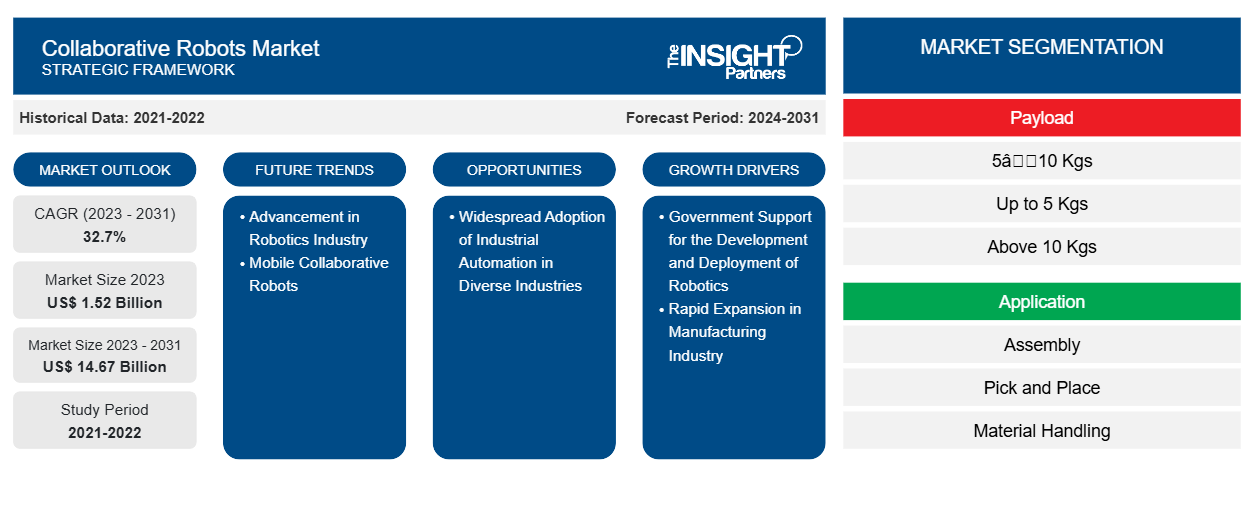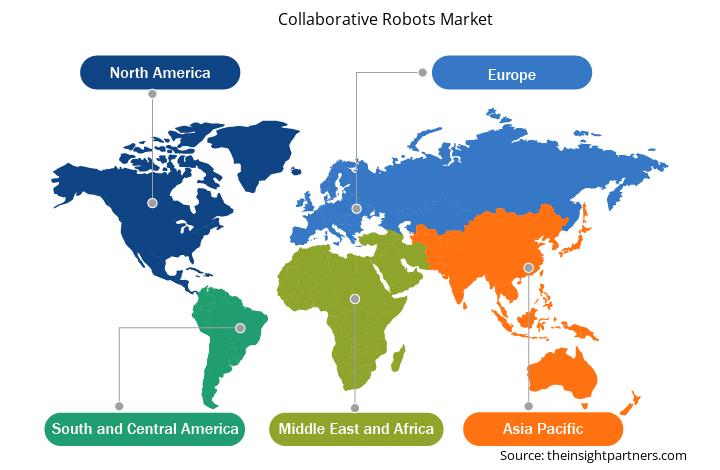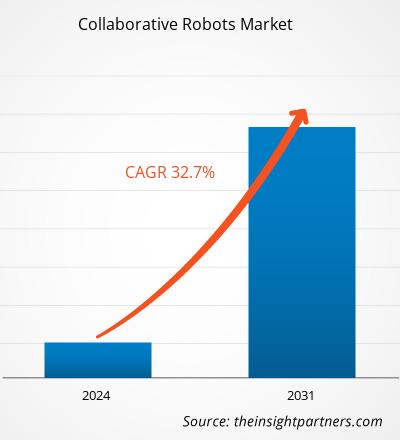Der Markt für kollaborative Roboter soll von 1,88 Milliarden US-Dollar im Jahr 2024 auf 14,67 Milliarden US-Dollar im Jahr 2031 anwachsen. Für den Zeitraum 2025–2031 wird eine durchschnittliche jährliche Wachstumsrate (CAGR) von 35,7 % erwartet. Mobile kollaborative Roboter dürften neue Trends auf dem Markt setzen.
Marktanalyse für kollaborative Roboter
Kollaborative Roboter sind eine Gruppe von Servicerobotern, die in der Materialhandhabung, der Fertigung und in Laboren eingesetzt werden. Die steigende Nachfrage in Fabriken – insbesondere im Fertigungssektor, wo Mensch und Roboter bereits harmonisch zusammenarbeiten – führt zu einem Marktwachstum für kollaborative Roboter . Das Aufkommen kollaborativer Roboter ermöglicht eine vertrauenswürdige Arbeitsumgebung, in der Menschen sicher mit Robotern zusammenarbeiten können. Zu den wichtigsten Markttreibern zählen die staatliche Förderung der Entwicklung und des Einsatzes von Robotik sowie die rasante Expansion in der Fertigungsindustrie.
Marktübersicht für kollaborative Roboter
Die Industrielandschaft befindet sich in einem tiefgreifenden Wandel, der maßgeblich durch den Aufstieg kollaborativer Roboter vorangetrieben wird – fortschrittliche Maschinen, die so konzipiert sind, dass sie sicher und effektiv mit Menschen zusammenarbeiten. Diese Roboter entwickeln sich zu intelligenten Teamkollegen, die die Sicherheit erhöhen, die Produktivität steigern und nachhaltige Betriebsabläufe unterstützen. Kollaborative Roboter arbeiten mit menschenähnlicher Geschwindigkeit und vereinfachen die bewegungsbezogene Risikobewertung. So können Bediener in der Nähe unbeabsichtigte Kontakte leichter vermeiden.
Die Regierungen mehrerer Länder weltweit ergreifen Initiativen, um die Entwicklung und Einführung von Robotik in ihren jeweiligen Ländern zu unterstützen und zu fördern. Solche Initiativen und Maßnahmen der Regierungen dürften das Marktwachstum für Industrierobotik weltweit vorantreiben und damit auch die Nachfrage nach kollaborativen Robotern steigern. Im Jahr 2022 hatte Europa den größten Umsatzanteil am globalen Markt für kollaborative Roboter. In Europa dürften der starke Automobilsektor und die Präsenz großer Premium-Automobilhersteller den Markt für kollaborative Roboter ankurbeln. Darüber hinaus wird erwartet, dass das Wachstum der Elektrofahrzeugproduktion das Marktwachstum für kollaborative Roboter vorantreiben wird.
Sie erhalten kostenlos Anpassungen an jedem Bericht, einschließlich Teilen dieses Berichts oder einer Analyse auf Länderebene, eines Excel-Datenpakets sowie tolle Angebote und Rabatte für Start-ups und Universitäten
Markt für kollaborative Roboter: Strategische Einblicke

- Informieren Sie sich über die wichtigsten Markttrends in diesem Bericht.Dieses KOSTENLOSE Beispiel umfasst Datenanalysen, von Markttrends bis hin zu Schätzungen und Prognosen.
Markttreiber und Chancen für kollaborative Roboter
Staatliche Unterstützung für die Entwicklung und den Einsatz von Robotik
Weltweit ergreifen Regierungen verschiedener Länder Initiativen, um die Entwicklung und Einführung von Robotik in ihren jeweiligen Ländern zu unterstützen und zu fördern. So kündigte beispielsweise die Regierung Singapurs im Rahmen ihres Industry Transformation Program mehrere Maßnahmen an, um Innovation, Automatisierung und Expansion von Unternehmen zu fördern und Finanzierungen zu sichern. Die indische Regierung hat verschiedene Maßnahmen ergriffen, um die intelligente Fertigung in Indien zu fördern, darunter das Production Linked Incentive (PLI)-Programm. Als wichtige Regierungsinitiative zur Förderung der indischen Fertigung wurde das PLI-Programm 2020 eingeführt und umfasst 14 Branchen, darunter die Automobil-, Pharma-, Textil-, Lebensmittel- und Haushaltsgeräteindustrie. Auch die chinesische Regierung hat verschiedene Maßnahmen zur Einführung von Industrierobotern im verarbeitenden Gewerbe des Landes ergriffen. Dazu gehört der Plan „Made in China 2025“ zur Entwicklung von Hochtechnologieindustrien. Darüber hinaus kündigte die Regierung einen fünfjährigen „Robotics Industry Development Plan“ zur Expansion der chinesischen Industrieroboterbranche an. Die Regierung bietet erhebliche Subventionen und Steuererleichterungen für die industrielle Automatisierung. Darüber hinaus umfasst die deutsche Initiative Industrie 4.0 die Entwicklung und den Einsatz von Industrierobotern. Die Bundesregierung kündigte an, Forschungsinstitute, Unternehmen und Hochschulen im Zeitraum 2016–2020 mit nicht rückzahlbaren Zuschüssen in Höhe von jährlich rund 78 Millionen US-Dollar bei der Erforschung der Mensch-Technik-Interaktion zu unterstützen. Derzeit bietet die Bundesregierung rund 300 Studiengänge im Bereich Automatisierung und Robotik an.
Die südkoreanische Regierung kündigte einen Investitionsplan in Höhe von 2,7 Millionen US-Dollar an: den zweiten Basisplan für die Entwicklung intelligenter Roboter (2014–2018). Nach Abschluss des zweiten Basisplans (2014–2018) formulierte die Regierung den dritten Basisplan für intelligente Roboter (2019–2023) und setzte ihn um.
Rasante Expansion in der Fertigungsindustrie
Die Industrielandschaft hat sich in letzter Zeit enorm weiterentwickelt, wobei kollaborative Roboter eine treibende Rolle bei der Umsetzung bedeutender Veränderungen spielen. Im Gegensatz zu herkömmlichen Robotern sind Cobots für die Zusammenarbeit mit Menschen konzipiert. Ihre Programmierung beinhaltet typischerweise Sicherheitsmaßnahmen, die menschliche Zusammenarbeit erfordern und ihren unabhängigen Betrieb einschränken. Dennoch bieten Cobots erhebliche Produktivitätssteigerungen und verbessern gleichzeitig die Sicherheit am Arbeitsplatz. Sie ermöglichen flexiblere und kostengünstigere Abläufe. Sie sind zu unverzichtbaren Bestandteilen moderner Industrien geworden und finden ihre Präsenz über die Fertigung hinaus auch in Logistik- und Gesundheitseinrichtungen weltweit.
In der Fertigungsindustrie werden Cobots häufig für Montage-, Schweiß-, Maschinenbedienungs- sowie Verpackungs- und Palettierungsaufgaben eingesetzt. Ihre Fähigkeit, repetitive und präzise Arbeitsabläufe auszuführen, verbessert die Produktqualität und reduziert die Ermüdung der Mitarbeiter. Durch die Automatisierung von Routineaufgaben ermöglichen Cobots es menschlichen Mitarbeitern, sich auf höherwertige Tätigkeiten zu konzentrieren. Dies verbessert letztlich die Produktivität, Effizienz und Arbeitssicherheit in der gesamten Fertigung. Die globale Fertigungsindustrie wächst rasant, und neue Regionen investieren in Produktionsanlagen. Diese Expansion fördert technologische Innovationen, um die Produktivität der Anlagen zu steigern, den Vorsprung gegenüber Kunden zu sichern und Wettbewerbsvorteile zu erlangen. Das rasante Wachstum der Fertigungsindustrie treibt somit die weltweite Nachfrage nach kollaborativen Robotern an.
Segmentierungsanalyse des Marktberichts für kollaborative Roboter
Wichtige Segmente, die zur Ableitung der Marktanalyse für kollaborative Roboter beigetragen haben, sind Nutzlast, Anwendung, Typ, Endbenutzerbranche und Funktionalität.
- Basierend auf der Nutzlast ist der Markt in 5–10 kg, bis 5 kg und über 10 kg segmentiert. Das Segment 5–10 kg hatte im Jahr 2024 den größten Marktanteil.
- Je nach Anwendung wird der Markt in Montage, Pick-and-Place, Materialhandhabung, Qualitätsprüfung, Maschinenbedienung, Schweißen, Verpackung und andere Bereiche unterteilt. Das Montagesegment hatte im Jahr 2024 den größten Marktanteil.
- Nach Typ ist der Markt in Roboterarme, Schweißpistolen, Greifer und andere unterteilt. Das Segment Roboterarme hatte im Jahr 2024 den größten Marktanteil.
- Nach Endverbraucherbranchen ist der Markt in die Branchen Automobil, Elektronik, Metall und Maschinenbau, Lebensmittel und Getränke, Logistik, Pharma und andere unterteilt. Das Automobilsegment dominierte den Markt im Jahr 2024.
- Nach Funktionalität ist der Markt in statische und mobile Roboter unterteilt. Das Segment der statischen Roboter dominierte den Markt im Jahr 2024.
Marktanteilsanalyse für kollaborative Roboter nach Geografie
Der geografische Umfang des Marktberichts für kollaborative Roboter ist hauptsächlich in fünf Regionen unterteilt: Nordamerika, Asien-Pazifik, Europa, Naher Osten und Afrika sowie Süd- und Mittelamerika.
Der asiatisch-pazifische Raum hatte 2024 einen bedeutenden Marktanteil im Bereich kollaborativer Roboter. Er umfasst viele Entwicklungsländer mit einem deutlichen Wachstum im Fertigungssektor. Die Region hat sich zu einem globalen Produktionszentrum mit vielfältigen Fertigungsindustrien entwickelt. Während sich China zu einem Zentrum für hochqualifizierte Fertigung entwickelt hat, ziehen Schwellenländer wie Indien, Südkorea, Taiwan und Vietnam zunehmend Unternehmen an, die ihre Fertigung für gering- bis mittelqualifizierte Tätigkeiten auslagern möchten. Diese Länder bieten wettbewerbsfähige Lohnkosten und fördern aktiv ausländische Direktinvestitionen durch unterstützende staatliche Initiativen. Um ihre Position als führende Produktionsstandorte in der Region zu festigen, müssen diese Länder jedoch Herausforderungen wie Fachkräftemangel, niedrige Produktivität und unterentwickelte Infrastruktur bewältigen.
Regierungen von Entwicklungsländern im asiatisch-pazifischen Raum bieten Steuererleichterungen, Fördermittel, Subventionen und andere Unterstützungsmaßnahmen an, um produzierende Unternehmen für die Ansiedlung von Werken in den jeweiligen Ländern zu gewinnen. Darüber hinaus haben mehrere Regierungen Initiativen wie „Made in China 2025“ und „Make in India“ ergriffen. China, der größte Produktionsstandort, verzeichnet jedoch aufgrund der alternden Bevölkerung steigende Arbeitskosten. Dies hat dazu geführt, dass produzierende Unternehmen Investitionen in südostasiatischen Ländern suchen. Die verbesserte Infrastruktur, der steigende Inlandskonsum und die niedrigeren Kosten sind einige der Faktoren, die produzierende Unternehmen in diese Länder locken.
China ist der weltweit größte Pkw-Produzent. Japan, Indien und Südkorea zählen zu den weiteren großen Fahrzeugherstellern im asiatisch-pazifischen Raum. Neben der Automobilindustrie setzen auch zahlreiche andere Branchen in China kollaborative Roboter ein. So wurden beispielsweise bei der Xiamen Runner Industrial Corporation – einem der größten Hersteller von Badezimmerzubehör in China – 64 Roboter von Universal Robots in der Produktion für verschiedene Aufgaben eingesetzt, von der Bedienung und Bedienung von Spritzgussmaschinen bis hin zur Produktmontage.
Regionale Einblicke in den Markt für kollaborative Roboter
Die Analysten von Insight Partners haben die regionalen Trends und Faktoren, die den Markt für kollaborative Roboter im Prognosezeitraum beeinflussen, ausführlich erläutert. Dieser Abschnitt behandelt auch die Marktsegmente und die geografische Lage für kollaborative Roboter in Nordamerika, Europa, Asien-Pazifik, dem Nahen Osten und Afrika sowie Süd- und Mittelamerika.

- Erhalten Sie regionale Daten zum Markt für kollaborative Roboter
Umfang des Marktberichts über kollaborative Roboter
| Berichtsattribut | Details |
|---|---|
| Marktgröße im Jahr 2025 | 1,88 Milliarden US-Dollar |
| Marktgröße bis 2031 | 14,67 Milliarden US-Dollar |
| Globale CAGR (2025 – 2031) | 35,7 % |
| Historische Daten | 2021-2023 |
| Prognosezeitraum | 2025–2031 |
| Abgedeckte Segmente | Nach Nutzlast
|
| Abgedeckte Regionen und Länder | Nordamerika
|
| Marktführer und wichtige Unternehmensprofile |
|
Marktdichte kollaborativer Roboter: Auswirkungen auf die Geschäftsdynamik
Der Markt für kollaborative Roboter wächst rasant. Die steigende Nachfrage der Endnutzer ist auf Faktoren wie veränderte Verbraucherpräferenzen, technologische Fortschritte und ein stärkeres Bewusstsein für die Produktvorteile zurückzuführen. Mit der steigenden Nachfrage erweitern Unternehmen ihr Angebot, entwickeln Innovationen, um den Bedürfnissen der Verbraucher gerecht zu werden, und nutzen neue Trends, was das Marktwachstum weiter ankurbelt.
Die Marktteilnehmerdichte beschreibt die Verteilung der in einem bestimmten Markt oder einer bestimmten Branche tätigen Unternehmen. Sie gibt an, wie viele Wettbewerber (Marktteilnehmer) in einem bestimmten Marktraum im Verhältnis zu dessen Größe oder Gesamtmarktwert präsent sind.
Die wichtigsten Unternehmen auf dem Markt für kollaborative Roboter sind:
- Kuka AG
- Yaskawa America Inc
- Aubo (Beijing) Robotics Technology Co Ltd
- Doosan Robotics Inc
- Fanuc Corp
- ABB Ltd
Haftungsausschluss : Die oben aufgeführten Unternehmen sind nicht in einer bestimmten Reihenfolge aufgeführt.

- Überblick über die wichtigsten Akteure auf dem Markt für kollaborative Roboter
Marktnachrichten und aktuelle Entwicklungen für kollaborative Roboter
Der Markt für kollaborative Roboter wird durch die Erhebung qualitativer und quantitativer Daten aus Primär- und Sekundärforschung bewertet, die wichtige Unternehmenspublikationen, Verbandsdaten und Datenbanken einbeziehen. Nachfolgend sind einige Entwicklungen im Markt für kollaborative Roboter aufgeführt:
- OMRON hat die Verfügbarkeit der kollaborativen Roboter der OMRON TM S-Serie angekündigt, die für vielfältige Anwendungen in verschiedenen Branchen entwickelt wurden. Diese Cobots verfügen über fortschrittliche Hardware, mehr Sicherheitsfunktionen und Zertifizierungen sowie Konfigurationsmöglichkeiten der nächsten Generation und sind dadurch einfacher zu bedienen als je zuvor. (Quelle: OMRON, Pressemitteilung, September 2024)
- Die TÜV Rheinland Group, eine international führende unabhängige Prüf-, Inspektions- und Zertifizierungsorganisation, hat der ESTUN Automation Co., Ltd. das CE-Zertifikat für Maschinenrichtlinie und Funktionale Sicherheit für ESS-Produkte (ESTUN Safety Solution) ausgestellt. Dies unterstreicht die schnellen Fortschritte von ESTUN beim Aufbau eines umfassenden Produkts für funktionale Robotersicherheit. Diese Zertifizierung unterstreicht nicht nur ESTUNs Innovationskraft und Professionalität im Bereich der Robotertechnologie, sondern spiegelt auch die strenge Kontrolle und das Engagement für Produktsicherheit und -qualität wider und wird die Servicequalität und Effizienz von ESTUN auf dem Weltmarkt weiter verbessern. (Quelle: ESTUN Robotics, Pressemitteilung, April 2024)
Marktbericht zu kollaborativen Robotern: Umfang und Ergebnisse
Der Bericht „Marktgröße und Prognose für kollaborative Roboter (2021–2031)“ bietet eine detaillierte Analyse des Marktes, die die folgenden Bereiche abdeckt:
- Marktgröße und Prognose für kollaborative Roboter auf globaler, regionaler und Länderebene für alle wichtigen Marktsegmente, die im Rahmen des Projekts abgedeckt sind
- Markttrends für kollaborative Roboter sowie Marktdynamiken wie Treiber, Einschränkungen und wichtige Chancen
- Detaillierte PEST- und SWOT-Analyse
- Marktanalyse für kollaborative Roboter mit wichtigen Markttrends, globalen und regionalen Rahmenbedingungen, wichtigen Akteuren, Vorschriften und aktuellen Marktentwicklungen
- Branchenlandschaft und Wettbewerbsanalyse mit Marktkonzentration, Heatmap-Analyse, prominenten Akteuren und aktuellen Entwicklungen auf dem Markt für kollaborative Roboter
- Detaillierte Firmenprofile
- Historische Analyse (2 Jahre), Basisjahr, Prognose (7 Jahre) mit CAGR
- PEST- und SWOT-Analyse
- Marktgröße Wert/Volumen – Global, Regional, Land
- Branchen- und Wettbewerbslandschaft
- Excel-Datensatz
Aktuelle Berichte
Erfahrungsberichte
Grund zum Kauf
- Fundierte Entscheidungsfindung
- Marktdynamik verstehen
- Wettbewerbsanalyse
- Kundeneinblicke
- Marktprognosen
- Risikominimierung
- Strategische Planung
- Investitionsbegründung
- Identifizierung neuer Märkte
- Verbesserung von Marketingstrategien
- Steigerung der Betriebseffizienz
- Anpassung an regulatorische Trends




















 Kostenlose Probe anfordern für - Markt für kollaborative Roboter
Kostenlose Probe anfordern für - Markt für kollaborative Roboter